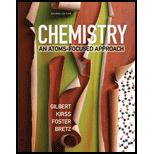
To determine:
The molality of each of the given solutions from given molarity and density
Answer to Problem 11.59QA
Solution:
a. Molality of CaCl2 = 1.34 m
b. Molality of fructose = 2.61 m
c. Molality of ethylene glycol = 17.4 m
d. Molality of LiCl = 2.05 m
Explanation of Solution
1. Formulae:
i. Molality of the solution is moles of solute divided by the mass of solvent in kg.
ii. Molarity of the solution is moles of solute divide by volume of solution in liter.
iii. Density of solution is mass divided by volume of solution
iv. Mass of the solution is mass of solvent and mass of solute
To calculate the molality of the solution, we need to calculate the moles of solute and mass of solvent in kg from the density and molarity.
A mole is the SI unit of amount chemical substance. When writing units, it is written as “mol”.
a. Molality of CaCl2
2. Given
i.
ii. Density (d)
3. Calculations
To calculate the moles of CaCl2 from
So, moles of solute
The mass of CaCl2 is
The density of the solution in g/L is
So,
We know the mass of CaCl2 and mass of solution; we can calculate the mass of solvent.
The molality of the CaCl2 solution from the moles and mass of solvent is
The molality of
b. Molality of fructose
2. Given
i.
ii. Density (d)
3. Calculations
To calculate the moles of C6H12O6 from
So, moles of solute
The mass of C6H12O6 is
The density of the solution in g/L is
So, 1 L of the solution contains 1139 g of solution.
We know the mass of solute C6H12O6 and mass of solution; we can calculate the mass of solvent.
The molality of the C6H12O6 solution from the moles and mass of solvent is
The molality of the
c. Molality of Ethylene glycol
2. Given
i.
ii. Density (d)
3. Calculations
To calculate the moles of ethylene glycol from
So, moles of solute
The mass of ethylene glycol is
The density of the solution in g/L is
So, 1 L of the solution contains 1069 g of solution.
We know the mass of ethylene glycol and mass of solution; we can calculate the mass of solvent.
The molality of the ethylene glycol solution from the moles and mass of solvent is
The molality of the
d. Molality of LiCl
2. Given
i.
ii. Density (d)
3. Calculations
To calculate the moles of LiCl from
So, moles of solute
The mass of LiCl is
The density of the solution in g/L is
So,
We know the mass of LiCl and mass of solution; we can calculate the mass of solvent.
The molality of the LiCl solution from the moles and mass of solvent is
The molality of
Conclusion:
Molality of the solution has been calculated from the molarity and density of the solution.
Want to see more full solutions like this?
Chapter 11 Solutions
CHEMISTRY:ATOMS-FOCUSED..-ACCESS
 ChemistryChemistryISBN:9781305957404Author:Steven S. Zumdahl, Susan A. Zumdahl, Donald J. DeCostePublisher:Cengage Learning
ChemistryChemistryISBN:9781305957404Author:Steven S. Zumdahl, Susan A. Zumdahl, Donald J. DeCostePublisher:Cengage Learning ChemistryChemistryISBN:9781259911156Author:Raymond Chang Dr., Jason Overby ProfessorPublisher:McGraw-Hill Education
ChemistryChemistryISBN:9781259911156Author:Raymond Chang Dr., Jason Overby ProfessorPublisher:McGraw-Hill Education Principles of Instrumental AnalysisChemistryISBN:9781305577213Author:Douglas A. Skoog, F. James Holler, Stanley R. CrouchPublisher:Cengage Learning
Principles of Instrumental AnalysisChemistryISBN:9781305577213Author:Douglas A. Skoog, F. James Holler, Stanley R. CrouchPublisher:Cengage Learning Organic ChemistryChemistryISBN:9780078021558Author:Janice Gorzynski Smith Dr.Publisher:McGraw-Hill Education
Organic ChemistryChemistryISBN:9780078021558Author:Janice Gorzynski Smith Dr.Publisher:McGraw-Hill Education Chemistry: Principles and ReactionsChemistryISBN:9781305079373Author:William L. Masterton, Cecile N. HurleyPublisher:Cengage Learning
Chemistry: Principles and ReactionsChemistryISBN:9781305079373Author:William L. Masterton, Cecile N. HurleyPublisher:Cengage Learning Elementary Principles of Chemical Processes, Bind...ChemistryISBN:9781118431221Author:Richard M. Felder, Ronald W. Rousseau, Lisa G. BullardPublisher:WILEY
Elementary Principles of Chemical Processes, Bind...ChemistryISBN:9781118431221Author:Richard M. Felder, Ronald W. Rousseau, Lisa G. BullardPublisher:WILEY





